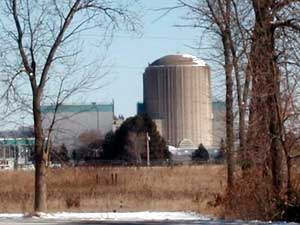Photos
More from MPR
Resources
Your Voice
| |||||||||||||||||||||||||||||||||||||||||||
A brief history of the Prairie Island plant
February 7, 2003
 |
| The Prairie Island nuclear power plant. (MPR Photo/Erin Galbally) |
Red Wing, Minn. —
A timeline of the Prairie Island power plant:
1940s: The Army Corps of Engineers sells land next to the Prairie Island Indian Community to Northern States Power Co. (NSP), for what's anticipated to be a coal-fired utility plant.
1973: NSP's Prairie Island nuclear power plant officially opens on the banks of the Mississippi River, about 10 miles north of Red Wing.
1989: NSP announces plans to develop a dry cask storage facility at Prairie Island to deal with unresolved problems storing spent nuclear fuel.
1994: The Minnesota Legislature approves the use of 17 dry casks to store nuclear waste. The approval comes with conditions. Lawmakers require NSP to make an annual investment in renewable energy (i.e. wind power). They also require the utility company to sign an agreement giving the Prairie Island Mdewakanton Dakota third-party status with standing to enforce the legislation.
1995: NSP begins loading the first cask with spent nuclear fuel.
2002: The federal government officially recommends Yucca Mountain in Nevada as a national repository for spent nuclear fuel. The plan faces several legal challenges.
Meanwhile, Xcel (formerly NSP) fills all 17 storage casks, the maximum allowed by the state of Minnesota. The plant still has enough storage capacity to stay online until 2007.
2003: Xcel returns to the Minnesota Legislature hoping for authorization to add additional dry cask storage space at Prairie Island. The Mdewakanton Dakota continue to oppose the storage plan. The community requests new land, an improved evacuation route, and a health and safety study in exchange for cooperation with the utility company.
|
News Headlines
|
Related Subjects
|

